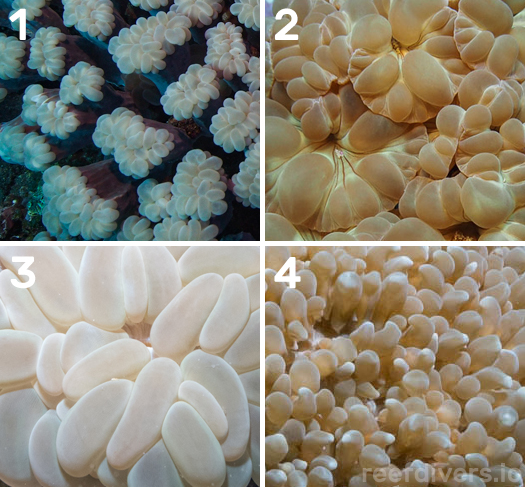Bubble Coral
Bubble Corals are found throughout the Indo-Pacific and can be recognized by their smoothy pearly vesicles. The bubble coral is not to be mistaken for a soft coral or fish eggs, bubble corals are stony corals with skeletons just below their fleshy surface.
During the day, bubble corals inflate their vesicles to acquire light for photosynthesis, at night the vesicles retract and feeding tentacles emerge. Bubble corals spend the evening waiting for zooplankton or anything tasty to drift by which they can quickly ensnare, and passed along to the coral mouths in the center of the polyps.
Bubble corals are found in protected habitats, with minimal flow. Bubble coral skeletons have thin circular shaped teeth, which could damage the delicate vesicles if they are hit or disturbed by high flow. Look for bubble corals on walls or overhangs in often turbid, cloudy water.
Identifying Bubble Coral
Learning to identify coral is a fun way to enrich your scuba diving experience. While each coral species share the same traits, the environment where the coral is living, affects their shape and color. When you know what to look for, the reef explodes with nooks and crannies where a diamond in the rough could be hiding.
There are four species of bubble coral in two genera (Plerogyra and Physogyra). All four species have distinct bubble shaped vesicles, and different corallite and skeletal structure, making each species of bubble corals straightforward to identify in the field.

The four types of bubble corals are: 1.Plerogyra simplex, 2.Plerogyra discus, 3.Plerogyra sinuosa and 4.Physogyra lichtensteini. As you can see these corals all have large fleshy vesicles, yet the similarity soon diverge.
Plerogyra simplex
Plerogyra simplex, also known as the Branching Bubble has recognizable corallites which form tubular branches. Each branch ends with dozens of smooth, pillow shaped vesicles. These are not to be mistaken for one coral.
The corallite branches all connect to a single base, allowing the coral to grow into very large colonies. This type of colony growth is called phaceloid, tubular corallite walls connecting to a single base, while other bubble’s are meandering with no branches.
Plerogyra discus
Plerogyra discus, the Fox Bubble has an elegant mantel with pronounced vesicles around the perimeter of the polyp. Vesicles can be slighting or completely inflated depending on the specimen.
Finding a magnificent fox bubble bouquet is on our coral bucket list. These corals are uncommon yet still possible to find. Get ready for the ultimate coral scavenger hunt. Plerogyra discus occurs from the Phillipines to Indonesia and parts of Papua New Guinea and the Solomon Islands.
Plerogyra sinuosa
Plerogyra sinuosa, the Bubble Coral has smooth grape like vesicles which cover a meandering skeleton. The bubble coral can be a small colony with several dozen vesicles or large and meandering corallites reaching several meters across.
The bubble coral grows thick corallite, which grow outwards like a maze. When polyps are retracted on large colonies you can easily see the corallites and valleys between them. Mary Stafford-Smith. Take a peak inside the polyps for bubble coral shrimp and other marine invertebrates.
Physogyra linchtenstini
The outlier in the bubble coral family is Physogyra linchtenstini, the Pearl Bubble. As the name implies, this coral has smaller pearl shaped bubbles which have a tear drop finish. Some pearl bubble can be tricky to identify without seeing the skeleton, as pearl bubble can also have smooth grape shaped bubbles.
Pearl bubble is the only coral in the genus Physogyra and the big difference here between Plerogyra sinuosa is growth form of the skeleton. Pearl bubble colonies can form thick plates which cover rocks and grow into massive colonies. The pearl bubble skeleton has a meandroid shape with short and widely separated valleys between corallites. In comparison the Plerogyra sinuosa has tall, thick coralites.
While it might seem daunting, learning to identify corals is easier than you think. Understanding a few key features will help you recognize more coral species each dive.
Have you seen a bubble coral? Leave your comments in the section below.


